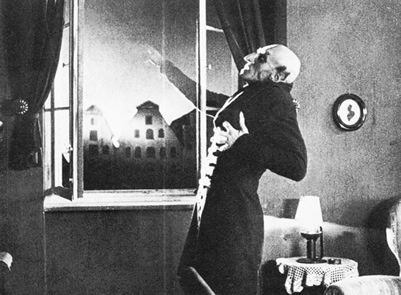Nosferatu: A Symphony of Horror
 Nosferatu released 1922
Nosferatu released 1922
Directed by F. W. Murnau
Screenplay by Henrik Galeen
Art Direction by Albin Grau
Nosferatu reflects Murnau's interest in the occult.
Producer Alben Grau, who also served as art director and costume designer, was a friend of the famous British occultist Alistair Crowley. Grau founded Prana Film to make movies about the occult (Prana also published a journal and sold occult items). Screen play author Henrik Galeen was also associated with occult organizations.
Nosferatu was clearly based on Bram Stoker's Dracula. However, Prana had not acquired rights to the story. Stoker's widow sued and Prana went bankrupt. Nosferatu was the only film the company ever made. Most copies of the film were destroyed as a result of the lawsuit. Despite this, the film was deeply influential
Staring Max Schreck (Orlok) (1879-1936). Schreck was a stage actor, part of Max Reinhardt's company. By odd coincidence, his name is also the German word for "fright" or "terror." Schreck had a substantial career both on stage and in movies after his appearance in Nosferatu but he's remembered chiefly for this role.
Gustav von Wangenheim (Hutter) (1895-1975), Appeared in over 200 films. von Wangenheim was a member of the German Communist Party. He fled to the Soviet Union with the rise of Hitler. He returned to East Germany after the war and worked for the state owned film studio.
Fun trivia: Count Orlock's house was actually the Salzpeicher warehouses in Lubeck, Germany. They were built between the 1500s and 1700s as warehouses for the local salt trade but also served many other purposes. Abandoned at the time of the filming, they survived the devastating 1942 bombing of Lubeck, and today are restored.

From here to the end of the class, for most films, you will need to read both my analysis of the film and a review by a well-known film critic.
Here's my analysis of Nosferatu
Here's a review by Roger Ebert
 Since the early days of the movies film reviewers have been important cultural voices and arbitrars of taste. Here's a short page on two of the 20th century's most influential reviewers, Bosley Crowther and Roger Ebert.
Since the early days of the movies film reviewers have been important cultural voices and arbitrars of taste. Here's a short page on two of the 20th century's most influential reviewers, Bosley Crowther and Roger Ebert.
One of the great things about film is that you don't need lots of training to become an expert. What you need is to watch a lot of films and think creatively about them. As we'll see later, some of the most famous film makers of the mid 20th century were just Paris street kids who loved films so much that that was all they wanted to do. In the 1990s James Berardinelli was an electrical engineer who loved films. He found he could write about them well and started the website Reelviews to publish his reviews. In a sense, he was at the right place at the right time. It was a lot easier to get noticed on the web in the early 1990s than it is today. Anyhow, Berardinelli writes excellent reviews and is widely recoginized as an important film critic. Here's his review of Nosferatu (note that he's wrong about Schreck. Quite a lot is known about his history).
Next up: Charlie Chaplin and City Lights